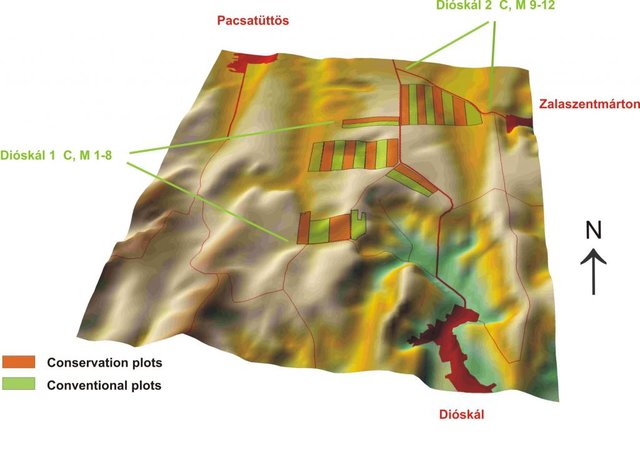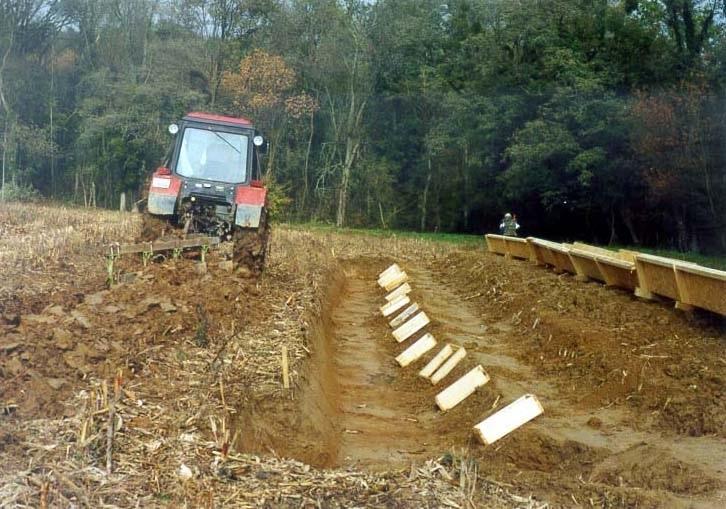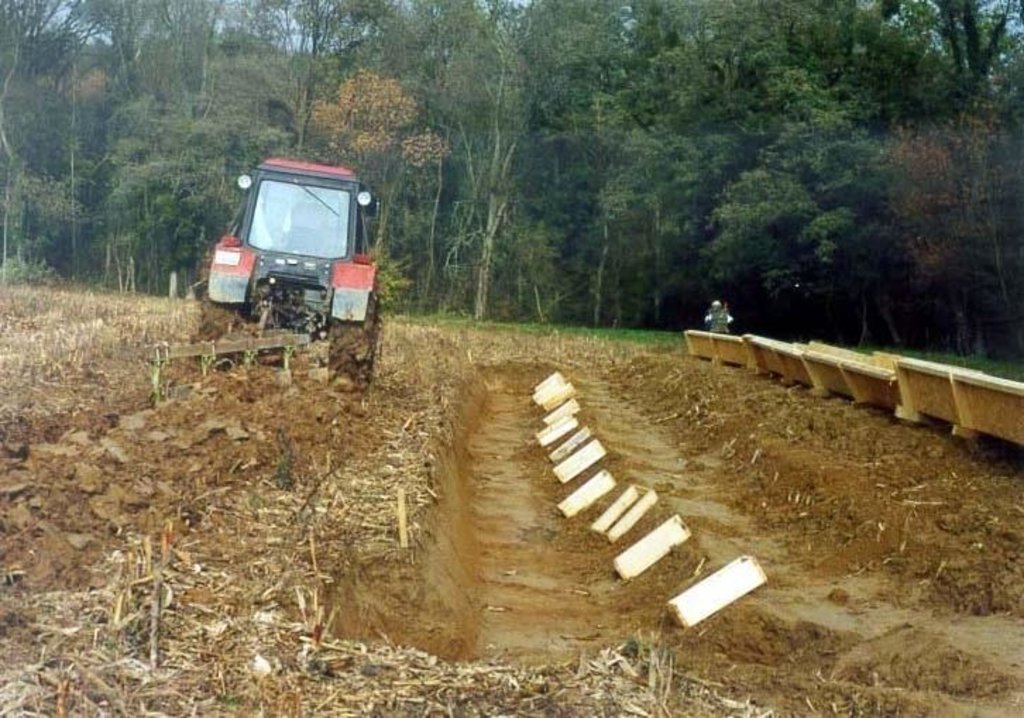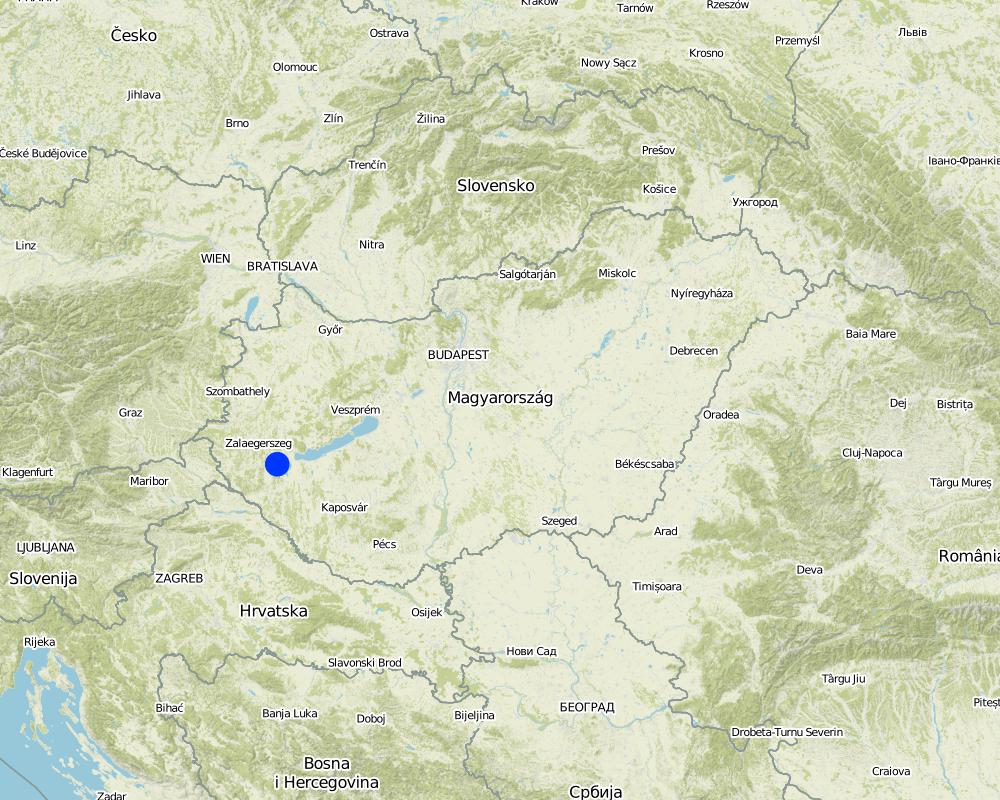Conventional (contour-line and ploughing) tillage [匈牙利]
- 创建:
- 更新:
- 编制者: Ádám Kertész
- 编辑者: –
- 审查者: David Streiff, Alexandra Gavilano
Hagyományos (szintvonalas és szántásos) müvelés (Hungarian)
technologies_1081 - 匈牙利
查看章节
全部展开 全部收起1. 一般信息
1.2 参与该技术评估和文件编制的资源人员和机构的联系方式
SLM专业人员:
SLM专业人员:
Csepinszky Béla
Geographical Research Institute, Hungarian Academy of Sciences
匈牙利
有助于对技术进行记录/评估的项目名称(如相关)
Soil and water protection (EU-SOWAP)有助于对技术进行记录/评估的机构名称(如相关)
Geographical Research Institute, Hungarian Academy of Sciences (MTA CSFK) - 匈牙利1.3 关于使用通过WOCAT记录的数据的条件
编制者和关键资源人员接受有关使用通过WOCAT记录数据的条件。:
是
1.5 参考关于SLM方法(使用WOCAT记录的SLM方法)的调查问卷

Conventional (contour-line and ploughing) tillage [匈牙利]
Conventional (contour-line and ploughing) tillage
- 编制者: Adam Kertesz
2. SLM技术的说明
2.1 技术简介
技术定义:
Conventional (contour-line and ploughing) tillage
2.2 技术的详细说明
说明:
The basis of the technology is the annual autumn ploughing. The ploughing and all other cultivation is carried out parallel to the contour lines. This way the erosion can be significantly decreased. The rotational cultivation aims at the reduction of the areal and fluvial erosion, at the repulsion of the weeds and at the attainment of the ideal state of the seedbed at the time of sowing. It is applicable anywhere bellow a certain slope angle. The only restriction is the excessively thin parcel structure.
Special education and investment are not required, it can be realised by the available instruments.
2.3 技术照片
2.5 已应用该技术的、本评估所涵盖的国家/地区/地点
国家:
匈牙利
区域/州/省:
Zala county
有关地点的进一步说明:
Zala county, Zala hills, Zala
具体说明该技术的分布:
- 均匀地分布在一个区域
如果技术均匀分布在一个区域,则指定覆盖的区域(单位为平方千米):
0.1963
如果不知道精确的区域,请注明大致覆盖的区域:
- 0.1-1 平方千米
注释:
Total area covered by the SLM Technology is 0.1963 km2.
Map
×2.6 实施日期
如果不知道确切的年份,请说明大概的日期:
- 50多年前(传统)
2.7 技术介绍
详细说明该技术是如何引入的:
- 作为传统系统的一部分(> 50 年)
3. SLM技术的分类
3.1 该技术的主要目的
- 减少、预防、恢复土地退化
3.2 应用该技术的当前土地利用类型

农田
- 一年一作
年作 - 具体指明作物:
- 谷物类 - 玉米
- 谷类 - 小麦(冬季)
每年的生长季节数:
- 1
具体说明:
Longest growing period in days: 185; Longest growing period from month to month: Apr - Oct
采用轮作制度了吗?:
是
如果是,请具体说明:
Relay cropping: wheat, maize
注释:
Major land use problems (compiler’s opinion): Fine loess soil with significant soil degradation, soil compaction due to inconvenient land use
Major land use problems (land users’ perception): EU and government rules, problems of the subsidy system, sales and marketing concerns
Type of cropping system and major crops comments: maize, winter wheat, maize…
3.4 供水
该技术所应用土地的供水:
- 雨养
3.5 该技术所属的SLM组
- 轮作制度(轮作、休耕、轮垦)
- 最小的土壤扰动
3.6 包含该技术的可持续土地管理措施

农艺措施
- A1:植被和土壤覆盖层
- A3:土壤表面处理
注释:
Type of agronomic measures: relay cropping, mineral (inorganic) fertilizers, soil conditioners (lime, gypsum), rotations / fallows, contour tillage
3.7 该技术强调的主要土地退化类型

土壤水蚀
- Wt:表土流失/地表侵蚀
- Wg:冲沟侵蚀/沟蚀
- Wm:块体运动/滑坡

物理性土壤退化
- Pc:压实
注释:
Secondary types of degradation addressed: Wm: mass movements / landslides, Pc: compaction
Main causes of degradation: reorganization of the ownerships, land subdivision
3.8 防止、减少或恢复土地退化
具体数量名该技术与土地退化有关的目标:
- 减少土地退化
4. 技术规范、实施活动、投入和成本
4.1 该技术的技术图纸
技术规范(与技术图纸相关):
Technical knowledge required for field staff / advisors: low
Technical knowledge required for land users: moderate
Main technical functions: control of concentrated runoff: impede / retard
Secondary technical functions: control of dispersed runoff: impede / retard, increase of infiltration
Relay cropping
Material/ species: wheat, maize
Quantity/ density: 5-6t/ha, 9
Rotations / fallows
Material/ species: wheat, maize
4.2 有关投入和成本计算的一般信息
其它/国家货币(具体说明):
Hungarian Forint
如相关,注明美元与当地货币的汇率(例如1美元=79.9巴西雷亚尔):1美元=:
195.8
注明雇用劳工的每日平均工资成本:
25.50
4.5 维护/经常性活动
| 活动 | 时间/频率 | |
|---|---|---|
| 1. | ploughing | autumn / annualy |
4.6 维护/经常性活动所需要的费用和投入(每年)
注释:
Machinery/ tools: plough, disc, roller, drill, tractor, sprayer, harvester
4.7 影响成本的最重要因素
描述影响成本的最决定性因素:
compacted soil surface> chiselling (loosening); steep slops>more fuel; nutrient supply>expensive inorganic fertilizers
5. 自然和人文环境
5.1 气候
年降雨量
- < 250毫米
- 251-500毫米
- 501-750毫米
- 751-1,000毫米
- 1,001-1,500毫米
- 1,501-2,000毫米
- 2,001-3,000毫米
- 3,001-4,000毫米
- > 4,000毫米
指定年平均降雨量(若已知),单位为mm:
650.00
农业气候带
- 半湿润
5.2 地形
平均坡度:
- 水平(0-2%)
- 缓降(3-5%)
- 平缓(6-10%)
- 滚坡(11-15%)
- 崎岖(16-30%)
- 陡峭(31-60%)
- 非常陡峭(>60%)
地形:
- 高原/平原
- 山脊
- 山坡
- 山地斜坡
- 麓坡
- 谷底
垂直分布带:
- 0-100 m a.s.l.
- 101-500 m a.s.l.
- 501-1,000 m a.s.l.
- 1,001-1,500 m a.s.l.
- 1,501-2,000 m a.s.l.
- 2,001-2,500 m a.s.l.
- 2,501-3,000 m a.s.l.
- 3,001-4,000 m a.s.l.
- > 4,000 m a.s.l.
关于地形的注释和进一步规范:
Altitudinal zone: ~ 200 m
5.3 土壤
平均土层深度:
- 非常浅(0-20厘米)
- 浅(21-50厘米)
- 中等深度(51-80厘米)
- 深(81-120厘米)
- 非常深(> 120厘米)
土壤质地(表土):
- 中粒(壤土、粉土)
表土有机质:
- 中(1-3%)
如有可能,附上完整的土壤描述或具体说明可用的信息,例如土壤类型、土壤酸碱度、阳离子交换能力、氮、盐度等。:
Soil fertility is medium
Soil drainage / infiltration is good
Soil water storage capacity is medium and sometimes high
5.6 应用该技术的土地使用者的特征
生产系统的市场定位:
- 商业/市场
相对财富水平:
- 平均水平
- 丰富
机械化水平:
- 机械化/电动
说明土地使用者的其他有关特征:
Population density: 50-100 persons/km2
Annual population growth: negative
Off-farm income specification: no off-farm income
5.7 应用该技术的土地使用者使用的平均土地面积
- < 0.5 公顷
- 0.5-1 公顷
- 1-2 公顷
- 2-5公顷
- 5-15公顷
- 15-50公顷
- 50-100公顷
- 100-500公顷
- 500-1,000公顷
- 1,000-10,000公顷
- > 10,000公顷
注释:
Also 100-500 ha and 500-1,000 ha
5.8 土地所有权、土地使用权和水使用权
土地所有权:
- 个人,有命名
土地使用权:
- 个人
6. 影响和结论性说明
6.1 该技术的现场影响
社会经济效应
生产
作物生产
收入和成本
农业收入
社会文化影响
SLM/土地退化知识
生态影响
土壤
土壤流失
其它生态影响
soil fertility
6.2 该技术的场外影响已经显现
下游洪水
下游淤积
地下水/河流污染
6.4 成本效益分析
技术收益与技术建立成本相比如何(从土地使用者的角度看)?
短期回报:
稍微积极
长期回报:
积极
技术收益与技术维护成本/经常性成本相比如何(从土地使用者的角度看)?
短期回报:
稍微积极
长期回报:
积极
6.5 技术采用
- 单例/实验
如若可行,进行量化(住户数量和/或覆盖面积):
1 household
在所有采用这项技术的人当中,有多少人是自发的,即未获得任何物质奖励/付款?:
- 91-100%
注释:
100% of land user families have adopted the Technology without any external material support
Comments on spontaneous adoption: survey results
There is a little trend towards spontaneous adoption of the Technology
6.7 该技术的优点/长处/机会
| 土地使用者眼中的长处/优势/机会 |
|---|
| production increase |
| no investment necessary |
| decreased soil erosion |
| 编制者或其他关键资源人员认为的长处/优势/机会 |
|---|
| decreased soil erosion |
| production increase |
| no investment necessary |
7. 参考和链接
7.1 信息的方法/来源
链接和模块
全部展开 全部收起链接

Conventional (contour-line and ploughing) tillage [匈牙利]
Conventional (contour-line and ploughing) tillage
- 编制者: Adam Kertesz
模块
无模块




